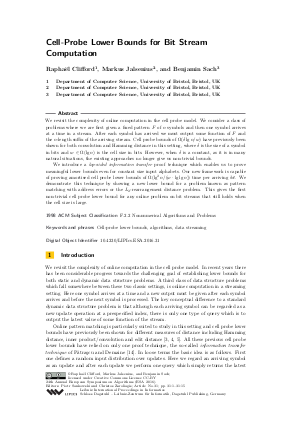Cell-Probe Lower Bounds for Bit Stream Computation
Authors Raphaël Clifford, Markus Jalsenius, Benjamin Sach
-
Part of:
Volume:
24th Annual European Symposium on Algorithms (ESA 2016)
Part of: Series: Leibniz International Proceedings in Informatics (LIPIcs)
Part of: Conference: European Symposium on Algorithms (ESA) - License:
 Creative Commons Attribution 3.0 Unported license
Creative Commons Attribution 3.0 Unported license
- Publication Date: 2016-08-18
File

PDF
LIPIcs.ESA.2016.31.pdf
- Filesize: 0.57 MB
- 15 pages
Document Identifiers
Subject Classification
Keywords
- Cell-probe lower bounds
- algorithms
- data streaming
Metrics
- Access Statistics
-
Total Accesses (updated on a weekly basis)
0Document
0Metadata
Abstract
We revisit the complexity of online computation in the cell probe model. We consider a class of problems where we are first given a fixed pattern F of n symbols and then one symbol arrives at a time in a stream. After each symbol has arrived we must output some function of F and the n-length suffix of the arriving stream. Cell probe bounds of Omega(delta lg n/w) have previously been shown for both convolution and Hamming distance in this setting, where delta is the size of a symbol in bits and w in Omega(lg n) is the cell size in bits. However, when delta is a constant, as it is in many natural situations, the existing approaches no longer give us non-trivial bounds. We introduce a lop-sided information transfer proof technique which enables us to prove meaningful lower bounds even for constant size input alphabets. Our new framework is capable of proving amortised cell probe lower bounds of Omega(lg^2 n/(w lg lg n)) time per arriving bit. We demonstrate this technique by showing a new lower bound for a problem known as pattern matching with address errors or the L_2-rearrangement distance problem. This gives the first non-trivial cell probe lower bound for any online problem on bit streams that still holds when the cell size is large.
Cite As Get BibTex
Raphaël Clifford, Markus Jalsenius, and Benjamin Sach. Cell-Probe Lower Bounds for Bit Stream Computation. In 24th Annual European Symposium on Algorithms (ESA 2016). Leibniz International Proceedings in Informatics (LIPIcs), Volume 57, pp. 31:1-31:15, Schloss Dagstuhl – Leibniz-Zentrum für Informatik (2016)
https://doi.org/10.4230/LIPIcs.ESA.2016.31
BibTex
@InProceedings{clifford_et_al:LIPIcs.ESA.2016.31,
author = {Clifford, Rapha\"{e}l and Jalsenius, Markus and Sach, Benjamin},
title = {{Cell-Probe Lower Bounds for Bit Stream Computation}},
booktitle = {24th Annual European Symposium on Algorithms (ESA 2016)},
pages = {31:1--31:15},
series = {Leibniz International Proceedings in Informatics (LIPIcs)},
ISBN = {978-3-95977-015-6},
ISSN = {1868-8969},
year = {2016},
volume = {57},
editor = {Sankowski, Piotr and Zaroliagis, Christos},
publisher = {Schloss Dagstuhl -- Leibniz-Zentrum f{\"u}r Informatik},
address = {Dagstuhl, Germany},
URL = {https://drops.dagstuhl.de/entities/document/10.4230/LIPIcs.ESA.2016.31},
URN = {urn:nbn:de:0030-drops-63827},
doi = {10.4230/LIPIcs.ESA.2016.31},
annote = {Keywords: Cell-probe lower bounds, algorithms, data streaming}
}
Author Details
References
-
A. Amir, Y. Aumann, G. Benson, A. Levy, O. Lipsky, E. Porat, S. Skiena, and U. Vishne. Pattern matching with address errors: rearrangement distances. In SODA'06: Proc. 17superscriptth ACM-SIAM Symp. on Discrete Algorithms, pages 1221-1229. ACM Press, 2006.

-
A. Amir, Y. Aumann, G. Benson, A. Levy, O. Lipsky, E. Porat, S. Skiena, and U. Vishne. Pattern matching with address errors: Rearrangement distances. Journal of Computer System Sciences, 75(6):359-370, 2009.

- R. Clifford and M. Jalsenius. Lower bounds for online integer multiplication and convolution in the cell-probe model. In ICALP'11: Proc. 38superscriptth International Colloquium on Automata, Languages and Programming, pages 593-604, 2011. URL: http://arxiv.org/abs/1101.0768.
- R. Clifford, M. Jalsenius, and B. Sach. Tight cell-probe bounds for online hamming distance computation. In SODA'13: Proc. 24superscriptth ACM-SIAM Symp. on Discrete Algorithms, pages 664-674, 2013. URL: http://arxiv.org/abs/1207.1885.
- R. Clifford, M. Jalsenius, and B. Sach. Cell-probe bounds for online edit distance and other pattern matching problems. In SODA'15: Proc. 26superscriptth ACM-SIAM Symp. on Discrete Algorithms, 2015. URL: http://arxiv.org/abs/1407.6559.
-
R. Clifford and B. Sach. Pattern matching in pseudo real-time. Journal of Discrete Algorithms, 9(1):67-81, 2011.

-
M. Fredman. Observations on the complexity of generating quasi-Gray codes. SIAM Journal on Computing, 7(2):134-146, 1978.

-
M. Fredman and M. Saks. The cell probe complexity of dynamic data structures. In STOC'89: Proc. 21superscriptst Annual ACM Symp. Theory of Computing, pages 345-354, 1989.

-
K. Green Larsen. The cell probe complexity of dynamic range counting. In STOC'12: Proc. 44superscriptth Annual ACM Symp. Theory of Computing, pages 85-94, 2012.

-
K. Green Larsen. Higher cell probe lower bounds for evaluating polynomials. In FOCS'12: Proc. 53superscriptrd Annual Symp. Foundations of Computer Science, pages 293-301, 2012.

-
M. Minsky and S. Papert. Perceptrons: An Introduction to Computational Geometry. MIT Press, 1969.

-
M. Pǎtraşcu. Lower bound techniques for data structures. PhD thesis, MIT, 2008.

-
M. Pǎtraşcu and E. D. Demaine. Tight bounds for the partial-sums problem. In SODA'04: Proc. 15superscriptth ACM-SIAM Symp. on Discrete Algorithms, pages 20-29, 2004.

-
M. Pătraşcu and E. D. Demaine. Logarithmic lower bounds in the cell-probe model. SIAM Journal on Computing, 35(4):932-963, 2006.

-
R.Clifford, A. Grønlund, and K. Green Larsen. New unconditional hardness results for dynamic and online problems. In FOCS'15: Proc. 56superscriptth Annual Symp. Foundations of Computer Science, pages 1089-1107, 2015.

-
A. Yao. Probabilistic computations: Toward a unified measure of complexity. In FOCS'77: Proc. 18superscriptth Annual Symp. Foundations of Computer Science, pages 222-227, 1977.

-
A. Yao. Should tables be sorted? Journal of the ACM, 28(3):615-628, 1981.

